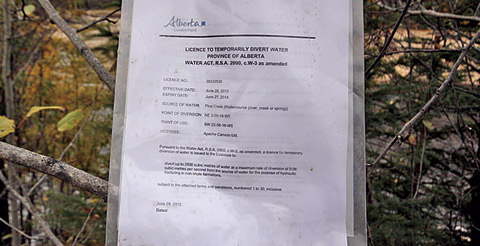|
 |
It’s called the Duvernay Shale Basin, an underground rock formation the size of South Korea that spans a large area of west central Alberta. The Duvernay is an unconventional resource play where oil and gas resources are trapped in rock that cannot be extracted by traditional methods. Instead, hydraulic fracturing—the injection of fluids under high pressure to crack the rock to allow oil and gas to flow—is used to capture the resources.
According to the Alberta Geological Survey, the Duvernay holds an estimated 62 billion barrels of oil and 443 trillion cubic feet of natural gas. As well, the area is rich in highly sought-after condensate, a light oil used to thin the thick bitumen produced in the oil sands so that it can flow through pipelines.
 |
| A licence to divert 2500 cubic metres of water from Pine Creek in the Duvernay. |
In an area already under siege by both oil and gas and forestry, to get these rich resources to the surface, the additional impact on this region will be devastating. Not only do the endangered Little Smoky and A La Peche Caribou Herds live in the Duvernay, so too does Alberta’s threatened bull trout, westslope cutthroat trout, Athabasca rainbow and Arctic grayling. Considering the amount of water required for hydraulic fracturing a single well, the effect on water levels could further impact these fish species.
In order to access the oil and gas, many multi-well pad sites will need to be constructed. These pad sites, of which there will be hundreds if not thousands are not small, each being 10 to 20 hectares (25 to 50 acres) in size with several wells on them. Each well will require anywhere from 10,000 to 60,000 cubic metres of water to fracture the rock below them. That’s as much as 16 million gallons of water for a single well.
The Smoky, Athabasca, and Saskatchewan River watersheds will be required to supply a vast amount of this water. Many lakes and streams in the area will be asked to share the burden. And once that water is gone, it’s gone for good.
Many roads will also need to be constructed to connect these pad sites, further decimating an area that is already at its threshold for industrial development.
The Alberta Trappers’ Association (ATA) also has concerns, as there are 87 Registered Fur Management Areas (RFMAs) in the “Pilot Project” area—an area with new “rules” to help streamline the application process for industry in the Duvernay.
The ATA is concerned that the removal of water from water bodies inhabited by beaver during the winter months “is merely a death sentence for those beaver.” As well, the impact on trapper’s livelihoods will be significant, as all furbearers from mink to muskrats to marten in the region will suffer population declines simply from habitat loss.
“We have several concerns with this project moving forward,” said Anne Coles, president of the ATA. “Our trappers bear the brunt of industry; both oil and gas and forestry have had huge impacts on our traplines. We need for others to be as concerned as we are for our furbearers where industrial activity is high.”
Darryl Smith, AFGA Provincial Fish Chair, also has concerns about the development of the Duvernay saying, “Woodland caribou, Arctic grayling, bull trout, Athabasca rainbow trout and many furbearers require linear and spatial thresholds at much lower values.”
But will anybody listen?
The Alberta Wilderness Association doesn’t think so, at least not without some prodding, recently announcing they were “taking the Minister of Fisheries and Oceans Canada to Federal Court over her failure to issue a critical habitat order for Alberta’s threatened population of westslope cutthroat trout.”
Low oil prices have slowed development in the Duvernay but rest assured, oil will eventually rebound to a profitable level... and that’s when the annihilation will begin. ■
For previous Outdoor Pursuits click here.
|
|
|
|


